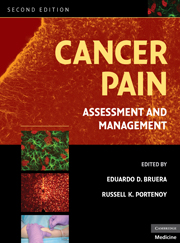Book contents
- Frontmatter
- Contents
- Contributors
- Preface
- SECTION I MECHANISMS AND EPIDEMIOLOGY
- SECTION II EPIDEMIOLOGY AND SYNDROMES
- SECTION III ASSESSMENT
- SECTION IV PHARMACOLOGICAL TREATMENT
- 9 Pharmacology of analgesia: basic principles
- 10 Pharmacogenetic considerations in the treatment of cancer pain
- 11 Pharmacology of opioid analgesia: clinical principles
- 12 Opioid side effects and management
- 13 Antipyretic analgesics
- 14 Adjuvant analgesic drugs
- 15 Neuraxial analgesia
- SECTION V OTHER INTERVENTIONAL STRATEGIES
- SECTION VI REHABILITATION AND PSYCHOLOGICAL INTERVENTIONS
- SECTION VII THE ROLE OF ANTINEOPLASTIC THERAPIES IN PAIN CONTROL
- SECTION VIII PAIN IN SPECIAL POPULATIONS
- SECTION IX DIFFICULT PAIN PROBLEMS
- SECTION X SYSTEMS OF CARE
- Index
- Plate section
- References
10 - Pharmacogenetic considerations in the treatment of cancer pain
from SECTION IV - PHARMACOLOGICAL TREATMENT
Published online by Cambridge University Press: 06 July 2010
- Frontmatter
- Contents
- Contributors
- Preface
- SECTION I MECHANISMS AND EPIDEMIOLOGY
- SECTION II EPIDEMIOLOGY AND SYNDROMES
- SECTION III ASSESSMENT
- SECTION IV PHARMACOLOGICAL TREATMENT
- 9 Pharmacology of analgesia: basic principles
- 10 Pharmacogenetic considerations in the treatment of cancer pain
- 11 Pharmacology of opioid analgesia: clinical principles
- 12 Opioid side effects and management
- 13 Antipyretic analgesics
- 14 Adjuvant analgesic drugs
- 15 Neuraxial analgesia
- SECTION V OTHER INTERVENTIONAL STRATEGIES
- SECTION VI REHABILITATION AND PSYCHOLOGICAL INTERVENTIONS
- SECTION VII THE ROLE OF ANTINEOPLASTIC THERAPIES IN PAIN CONTROL
- SECTION VIII PAIN IN SPECIAL POPULATIONS
- SECTION IX DIFFICULT PAIN PROBLEMS
- SECTION X SYSTEMS OF CARE
- Index
- Plate section
- References
Summary
Introduction
Pain perception shows interindividual variability. This variability is partly related to gender and ethnicity, suggesting that genetic factors cause interindividual differences in pain. Besides genetic variability related to pain perception, genetic variants are associated with painful conditions such as migraine or fibromyalgia. Finally, and the primary focus of this book chapter, the pain experience may be subject to genetic variability related to efficacy of analgesics. For cancer pain, this variability is supported by the large variations among individuals in opioid doses needed for pain control, a variation that partly remains if the observations include patients at a defined stage of cancer pain. Similar variations in need for opioid doses are observed in studies in patients receiving opioids for postoperative pain following a standardized surgical procedure, even when factors such as pain intensity or age are controlled.
The complexity of genetic variability related to drug effects is high. Most drugs effects, including those of opioids, are influenced by several gene products. These gene products are involved in both pharmacokinetics (metabolism and transport) and pharmacodynamics (receptor interaction, opioid signaling, and modulation of opioid effects). Thus, effects elicited by opioids are truly polygenic traits. In addition, genes can interact with one another. Interactions between genes – gene joint effects – may enhance, suppress, or have no effect on the outcome.
Mechanisms of genetic variation
Single nucleotide polymorphisms
A single nucleotide polymorphism (SNP) is a change in a single DNA base in the DNA sequence.
- Type
- Chapter
- Information
- Cancer PainAssessment and Management, pp. 180 - 194Publisher: Cambridge University PressPrint publication year: 2009



